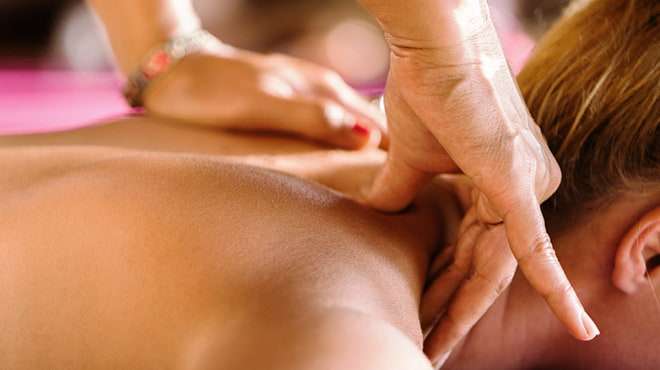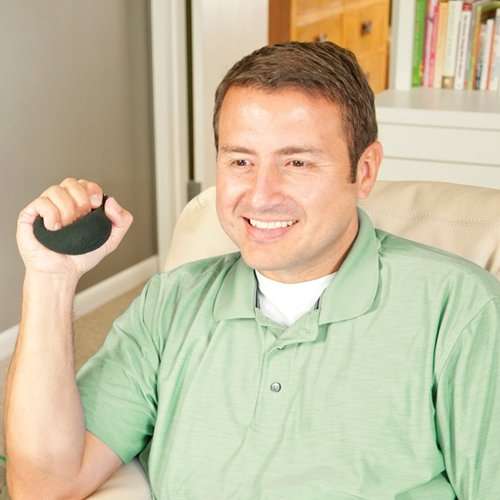Stress is an inevitable part of life. It is nearly impossible to remove all stress from day-to-day life. Stress is physiological and psychological responses to situations the body and mind find to be overwhelming.
Even situations perceived as good, like getting married, starting a new job or becoming a parent, can produce significant stress. When people struggle to cope with stressful situations, depression and anxiety symptoms can become more noticeable.
Massage therapy is one of many ways to cope with stress, and treat anxiety and depression.
Some people mistakenly believe that massage therapy is only for pampering yourself. While this is true for some people, it also helps manage anxiety, depression and insomnia.
Physical benefits of massage
A massage does more than just feel good. It can lower the amount of cortisol in your body. This hormone is produced when your body is stressed. It increases glucose in your bloodstream, enhances your brain’s use of glucose and curbs functions that are nonessential in a fight-or-flight situation.
A one-hour massage lowers cortisol in your body while also releasing serotonin. This hormone neurotransmitter is sometimes called the “happy chemical” because it reduces feelings of depression and carries signals between nerves and your body. By lowering cortisol and increasing serotonin, you’re boosting your body’s ability to fight off pain, anxiety and feelings of sadness.
Also, massage could be considered an hourlong hug, as it can fulfill the need for human contact and comforting touch. A session provides you with a nurturing safe place to physically rest.
Emotional benefits of massage
Massage provides many emotional benefits, which can be just as important as the physical benefits. Many people say that after a massage they feel more relaxed and calmer. It a safe and nurturing place for people to refocus and find clarity.
Massage can lower stress levels and feelings of anxiety. It can improve mood and relaxation while increasing confidence and self-image.
If you experience depression or anxiety, or are just overloaded with extra stress, massage can be an effective part of treatment. It can create a sense of relief and empowerment, and allow you to focus on your mind-body connection.
Massage therapists listen to your needs and concerns. They can develop a treatment plan to decrease stress and symptoms of anxiety and depression. Sessions range from 15 to 90 minutes in length. Therapeutic massage may help support you on your mental health journey.
Massage alters EEG activity, increases parasympathetic activity, and decreases cortisol levels
Massage is widely used in all cultures to evoke feelings of deep relaxation and reduced anxiety. The anxiety-reducing and mood-enhancing benefits of massage are probably related to changes in EEG activity, decreased levels of cortisol, and increased activity of the parasympathetic nervous system, which acts automatically to calm the body and brain during stress.
Numerous studies show that moderate pressure massage is more effective than light pressure massage for reducing pain associated with different medical problems including fibromyalgia and rheumatoid arthritis. Moderate pressure massage also improves attention and enhances the body’s immune response by increasing the activity of natural killer cells. Functional brain imaging studies show that changes take place in many areas of the brain involved in regulating emotions and stress response including the amygdala and the hypothalamus. For an excellent review of the research evidence for massage therapy see “Massage Therapy Research Review” by Field (Field 2014).
Challenges to designing studies on massage
It is difficult to examine the beneficial effects of massage therapy using contemporary research methods because it is impossible to design a double-blind study in which the person receiving massage therapy is “blinded” to treatment. Also, the physical and psychological benefits of massage are difficult to quantify in controlled trials. Findings of many studies are limited by the absence of a sham control group i.e., a group treated by someone who poses as a massage therapist but has no training. The situation is further complicated by the fact that few massage therapists are trained in research methods or work in institutional settings where sham-controlled trials can be conducted.
Massage is widely used for anxiety and has a strong record of success
In spite of the paucity of published research evidence, regular massage is a widely used technique in many cultures to treat chronic stress and anxiety and deserves serious consideration. Consistent anecdotal evidence, a long history of widespread use of massage for stress reduction, and positive findings of open trials support the view that regular massage therapy reduces the severity of chronic moderate anxiety in general, and specifically when anxiety is related to test-taking or problem-solving, work stress or the anticipation of invasive medical procedures.
In my own clinical experience working with patients who complain of chronic stress, test-taking stress, and generalized anxiety, regular massage therapy effectively reduces anxiety, improves emotional resilience, and enhances feelings of general well-being in anxious patients.
Few safety issues
Massage is safe when done by a trained therapist, seldom resulting in injuries. However, individuals who have chronic pain disorders or other medical conditions that involve the musculoskeletal system should consult with their physician before receiving regular massage therapy.
Massage: Get in touch with its many benefits
Massage can be a powerful tool to help you take charge of your health and well-being. See if it’s right for you.
By Mayo Clinic Staff
Massage used to be available only through luxury spas and upscale health clubs. Today, massage therapy is offered in businesses, clinics, hospitals and even airports. If you’ve never tried massage, learn about its possible health benefits and what to expect during a massage therapy session.
What is massage?
Massage is a general term for pressing, rubbing and manipulating your skin, muscles, tendons and ligaments. Massage may range from light stroking to deep pressure. There are many different types of massage, including these common types:
- Swedish massage. This is a gentle form of massage that uses long strokes, kneading, deep circular movements, vibration and tapping. It helps you feel relaxed and energized.
- Deep massage. This massage technique uses slower, more-forceful strokes to target the deeper layers of muscle and connective tissue. It’s commonly used to help with muscle damage from injuries.
- Sports massage. This is similar to Swedish massage, but it’s geared toward people involved in sport activities to help prevent or treat injuries.
- Trigger point massage. This massage focuses on areas of tight muscle fibers that can form in your muscles after injuries or overuse.
Benefits of massage
Massage is generally considered part of integrative medicine. It’s increasingly being offered along with standard treatment for a wide range of medical conditions and situations.
Massage benefits can include:
- Reducing stress and increasing relaxation
- Reducing pain and muscle soreness and tension
- Improving circulation, energy and alertness
- Lowering heart rate and blood pressure
- Improving immune function
While more research is needed to confirm the benefits of massage, some studies have found massage may also be helpful for:
- Anxiety
- Digestive disorders
- Fibromyalgia
- Headaches
- Insomnia related to stress
- Low back pain
- Myofascial pain syndrome
- Nerve pain
- Soft tissue strains or injuries
- Sports injuries
- Temporomandibular joint pain
- Upper back and neck pain
Beyond the benefits for specific conditions or diseases, some people enjoy massage because it often produces feelings of caring, comfort and connection.
Despite its benefits, massage isn’t meant as a replacement for regular medical care. Let your doctor know you’re trying massage and be sure to follow any standard treatment plans you have.
Risks of massage
Most people can benefit from massage. However, massage may not be appropriate if you have:
- Bleeding disorders or take blood-thinning medication
- Burns or healing wounds
- Deep vein thrombosis
- Infections
- Broken bones (fractures)
- Severe osteoporosis
- A very low platelet count (severe thrombocytopenia)
Discuss the pros and cons of massage with your doctor, especially if you are pregnant or if you have cancer or unexplained pain.
Some forms of massage can leave you feeling a bit sore the next day. But massage shouldn’t ordinarily be painful or uncomfortable. If any part of your massage doesn’t feel right or is painful, speak up right away. Most serious problems come from too much pressure during massage.
What you can expect during a massage
You don’t need any special preparation for massage. Before a massage therapy session starts, your massage therapist should ask you about any symptoms, your medical history and what you’re hoping to get out of massage. Your massage therapist should explain the kind of massage and techniques he or she will use.
In a typical massage therapy session, you undress or wear loose-fitting clothing. Undress only to the point that you’re comfortable. You generally lie on a table and cover yourself with a sheet. Your massage therapist will leave the room when you undress before the massage and when you dress after it. You can also have a massage while sitting in a chair, fully clothed. Your massage therapist should perform an evaluation through touch to locate painful or tense areas and to determine how much pressure to apply.
Depending on preference, your massage therapist may use oil or lotion to reduce friction on your skin. Tell your massage therapist if you might be allergic to any ingredients.
A massage session may last from 10 to 90 minutes, depending on the type of massage and how much time you have. No matter what kind of massage you choose, you should feel calm and relaxed during and after your massage. Breathe normally throughout your massage.
Your massage therapist may play music during your massage or talk to you, but you can tell him or her if you prefer quiet.
If a massage therapist is pushing too hard, ask for lighter pressure. Occasionally you may have a sensitive spot in a muscle that feels like a knot. It’s likely to be uncomfortable while your massage therapist works it out. But if it becomes painful, speak up.
Finding a massage therapist
Ask your doctor or someone else you trust for a recommendation. Most states regulate massage therapists through licensing, registration or certification requirements.
Don’t be afraid to ask a potential massage therapist such questions as:
- Are you licensed, certified or registered?
- What is your training and experience?
- How many massage therapy sessions do you think I’ll need?
- What’s the cost, and is it covered by health insurance?
The take-home message about massage
Brush aside any thoughts that massage is only a feel-good way to indulge or pamper yourself. To the contrary, massage can be a powerful tool to help you take charge of your health and well-being, whether you have a specific health condition or are just looking for another stress reliever. You can even learn how to do self-massage or how to engage in massage with a partner at home.
There is a problem with information submitted for this request. Review/update the information highlighted below and resubmit the form.
From Mayo Clinic to your inbox
Sign up for free, and stay up to date on research advancements, health tips and current health topics, like COVID-19, plus expertise on managing health.
ErrorEmail field is required
ErrorInclude a valid email address
To provide you with the most relevant and helpful information, and understand which information is beneficial, we may combine your email and website usage information with other information we have about you. If you are a Mayo Clinic patient, this could include protected health information. If we combine this information with your protected health information, we will treat all of that information as protected health information and will only use or disclose that information as set forth in our notice of privacy practices. You may opt-out of email communications at any time by clicking on the unsubscribe link in the e-mail.
Thank you for subscribing!
You’ll soon start receiving the latest Mayo Clinic health information you requested in your inbox.
Sorry something went wrong with your subscription
Please, try again in a couple of minutes
- Massage therapy: What you need to know. National Center for Complementary and Integrative Health. https://www.nccih.nih.gov/health/massage-therapy-what-you-need-to-know. Accessed Dec. 18, 2020.
- AskMayoExpert. Massage therapy. Mayo Clinic; 2019.
- What to expect at your massage session. American Massage Therapy Association. https://www.amtamassage.org/find-massage-therapist/what-to-expect-at-massage-session/. Accessed Dec. 18, 2020.
- 6 things to know when selecting a complementary health practitioner. National Center for Complementary and Integrative Health. https://www.nccih.nih.gov/health/tips/things-to-know-when-selecting-a-complementary-health-practitioner. Accessed Dec. 18, 2020.
- Goldman L, et al., eds. Complementary, alternative, and integrative medicine. In: Goldman-Cecil Medicine. 26th ed. Elsevier; 2020. https://www.clinicalkey.com. Accessed Dec. 18, 2020.
- Benzon HT, et al, eds. Physical medicine techniques in pain management. In: Practical Management of Pain. 5th ed. Mosby Elsevier; 2014. https://www.clinicalkey.com. Accessed Dec. 18, 2020.
See more In-depth




